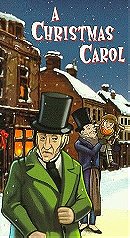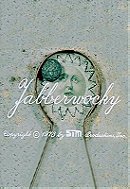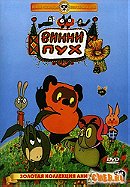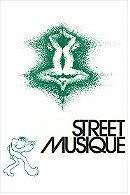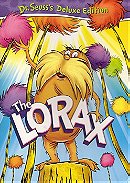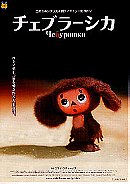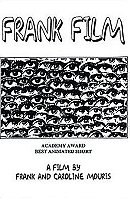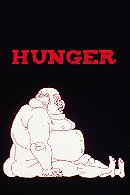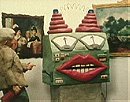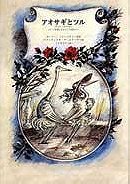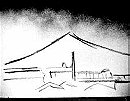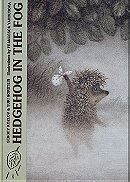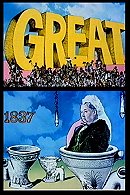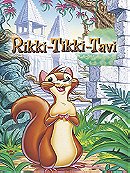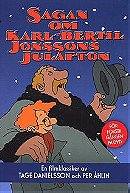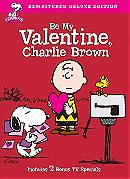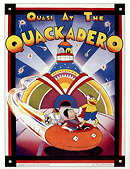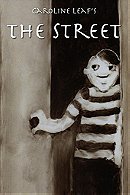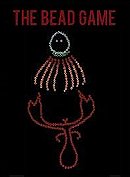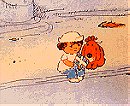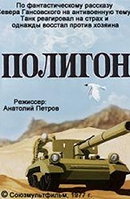1001 Animated Shorts You Must See - Part 10
Sort by:
Showing 50 items
Decade:
Rating:
List Type:
The Roll-Call (1971)
DIR: Ryszard Czekala
SUMMARY: A roll call in a concentration camp ends in tragedy when the prisoners begin to defy orders.
WHY IT'S HERE: Ryszard Czekala's chilling animation 'The Roll-Call' depicts life in a concentration camp in a simple, repetitive but extraordinarily effective way. As viewers, we watch the proceedings through the viewpoint of a faceless member of the crowd of prisoners as a tyrannical leader barks orders, pointlessly commanding the prisoners to bow down and get back up over and over again. This seemingly endless string of commands is broken up when one member of the crowd chooses to disobey, an action which leads to further rebellion and, ultimately, mass murder. 'The Roll-Call' has the simplest of plots but Czekala brilliantly depicts the dehumanisation of the prisoners, making them seem like a mass of fabric fibres rather than individual human beings. The repetition becomes almost unbearable but the relief we feel at the eventual defiance is tempered by terror and the ultimate fate of the rebels leads us to question what is better - a violent death or a state of living nothingness.
SUMMARY: A roll call in a concentration camp ends in tragedy when the prisoners begin to defy orders.
WHY IT'S HERE: Ryszard Czekala's chilling animation 'The Roll-Call' depicts life in a concentration camp in a simple, repetitive but extraordinarily effective way. As viewers, we watch the proceedings through the viewpoint of a faceless member of the crowd of prisoners as a tyrannical leader barks orders, pointlessly commanding the prisoners to bow down and get back up over and over again. This seemingly endless string of commands is broken up when one member of the crowd chooses to disobey, an action which leads to further rebellion and, ultimately, mass murder. 'The Roll-Call' has the simplest of plots but Czekala brilliantly depicts the dehumanisation of the prisoners, making them seem like a mass of fabric fibres rather than individual human beings. The repetition becomes almost unbearable but the relief we feel at the eventual defiance is tempered by terror and the ultimate fate of the rebels leads us to question what is better - a violent death or a state of living nothingness.
DIR: Dale Case, Robert Mitchell
SUMMARY: Uncle Sam and his American eagle sidekick battle to rescue the Statue of Liberty from villainous captors.
WHY IT'S HERE: 'The Further Adventures of Uncle Sam: Part Two' is a significantly dated animation but it is also a fascinating time capsule of early 70s animation, being firmly rooted in the 60s underground comics scene and owing more than a little to 'Yellow Submarine'. Mixing patriotism with a keen awareness of the state of the country at the time, 'The Further Adventures of Uncle Sam: Part Two' casts the titular American icon as a sort of ineffectual superhero, aided by his far more heroic American eagle sidekick. Together they must rescue the Statue of Liberty herself from those American villains who would keep her in chains. It's a nifty little piece, making up for its technical shortcomings with a high level of charm which makes it infinitely rewatchable.
SUMMARY: Uncle Sam and his American eagle sidekick battle to rescue the Statue of Liberty from villainous captors.
WHY IT'S HERE: 'The Further Adventures of Uncle Sam: Part Two' is a significantly dated animation but it is also a fascinating time capsule of early 70s animation, being firmly rooted in the 60s underground comics scene and owing more than a little to 'Yellow Submarine'. Mixing patriotism with a keen awareness of the state of the country at the time, 'The Further Adventures of Uncle Sam: Part Two' casts the titular American icon as a sort of ineffectual superhero, aided by his far more heroic American eagle sidekick. Together they must rescue the Statue of Liberty herself from those American villains who would keep her in chains. It's a nifty little piece, making up for its technical shortcomings with a high level of charm which makes it infinitely rewatchable.
Evolution (1971)
DIR: Michael Mills
SUMMARY: The story of evolution is played out across 10 short minutes.
WHY IT'S HERE: The National Film Board of Canada's 'Evolution' condenses the story of evolution into 10 very funny minutes. The character designs are appealingly cartoony and Michael Mills' animation is full of energy. Mills would later make an even more ambitious attempt to condense a greater time period into an even smaller space with 'History of the World in Three Minutes Flat' but 'Evolution' gives the viewer more time to enjoy Mills' attractive designs and intrinsically funny characters, while remaining faithful to the facts. From the single-celled amoebae to the first amphibious creatures and the forefathers of Homo sapiens, Mills gets it all in there, with plenty of room for laughs in between.
SUMMARY: The story of evolution is played out across 10 short minutes.
WHY IT'S HERE: The National Film Board of Canada's 'Evolution' condenses the story of evolution into 10 very funny minutes. The character designs are appealingly cartoony and Michael Mills' animation is full of energy. Mills would later make an even more ambitious attempt to condense a greater time period into an even smaller space with 'History of the World in Three Minutes Flat' but 'Evolution' gives the viewer more time to enjoy Mills' attractive designs and intrinsically funny characters, while remaining faithful to the facts. From the single-celled amoebae to the first amphibious creatures and the forefathers of Homo sapiens, Mills gets it all in there, with plenty of room for laughs in between.
DIR: Richard Williams
SUMMARY: An animated version of Charles Dickens' famous festive tale.
WHY IT'S HERE: Not only is 'A Christmas Carol' one of my favourite stories of all time but Richard Williams' stunning animated adaptation is my favourite version, even beating out the great Alistair Sim live-action version. Sim, always the definitive Scrooge, reprises his role here in voice-over but he is upstaged (possibly for the only time in his glorious career) by the eye-popping animation style. This is a move away from the limited animation style if ever there was one. A stunning mix of pans and zooms with artwork based on 19th century engraved illustrations, 'A Christmas Carol' is a true masterwork.
SUMMARY: An animated version of Charles Dickens' famous festive tale.
WHY IT'S HERE: Not only is 'A Christmas Carol' one of my favourite stories of all time but Richard Williams' stunning animated adaptation is my favourite version, even beating out the great Alistair Sim live-action version. Sim, always the definitive Scrooge, reprises his role here in voice-over but he is upstaged (possibly for the only time in his glorious career) by the eye-popping animation style. This is a move away from the limited animation style if ever there was one. A stunning mix of pans and zooms with artwork based on 19th century engraved illustrations, 'A Christmas Carol' is a true masterwork.
Jabberwocky (1971)
DIR: Jan Svankmajer
SUMMARY: Lewis Carroll's poem 'Jabberwocky' is recited as toys come alive in a child's playroom patrolled by a destructive cat.
WHY IT'S HERE: Jan Svankmajer's first adaptation of Lewis Carroll is a lot more tenuously related to the source material than his masterful feature length adaptation of 'Alice's Adventures in Wonderland' but it feels like an obvious forerunner for that film. Inspired by Carroll rather than being a direct adaptation, 'Jabberwocky' is a fantastic animation of a child's playroom coming to life before being destroyed by a live action cat. 'Jabberwocky' has similarities with earlier Svankmajer shorts in which objects come to life but this particular short has a sense of creepy majesty that sets it apart. The Lewis Carroll material is quickly swept aside but the great writer's influence never vanishes from 'Jabberwocky', demonstrating what a superb match these two masters of their arts were.
SUMMARY: Lewis Carroll's poem 'Jabberwocky' is recited as toys come alive in a child's playroom patrolled by a destructive cat.
WHY IT'S HERE: Jan Svankmajer's first adaptation of Lewis Carroll is a lot more tenuously related to the source material than his masterful feature length adaptation of 'Alice's Adventures in Wonderland' but it feels like an obvious forerunner for that film. Inspired by Carroll rather than being a direct adaptation, 'Jabberwocky' is a fantastic animation of a child's playroom coming to life before being destroyed by a live action cat. 'Jabberwocky' has similarities with earlier Svankmajer shorts in which objects come to life but this particular short has a sense of creepy majesty that sets it apart. The Lewis Carroll material is quickly swept aside but the great writer's influence never vanishes from 'Jabberwocky', demonstrating what a superb match these two masters of their arts were.
Mr. Rossi at Photo Safari (1971)
DIR: Bruno Bozzetto
SUMMARY: Mr. Rossi heads off to Africa in the hope of photographing some wild animals but his attempts to capture the beasts on film are thwarted at every turn by crowds of big game hunters.
WHY IT'S HERE: Bruno Bozzetto's sixth Mr. Rossi short continues the series' drift into darker subject matter, once again portraying Rossi's frustrations as a rapid descent into murderous insanity. Here we find Rossi heading out to Africa where he wants to photograph some wild animals. It begins like the more innocuous early Rossi shorts, with lots of sweet jokes about travelling and holiday accommodation but the minute Rossi pulls out his camera the mood darkens, as hoards of hunters appear and shower his subjects with bullets before he can get a picture (in one particularly gruesome case, the hunters climb into an elephant's mouth and shoot him from the inside out!). The repeated murder of his beloved creatures eventually causes Rossi to follow suit, swiftly despatching the hunters with a series of deadly weapons. Unlike its predecessor, 'Mr. Rossi Goes Camping', which turned so dark at its climax that it was eerily strange, 'Mr. Rossi at Photo Safari' works within a series of recognisable comic parameters which make Rossi's final psychotic outburst humorous rather than troubling. Nevertheless, Bozzetto's Rossi series had by this point become more notable for its dark satirical bent than for the chucklesome spot gags of its early instalments.
SUMMARY: Mr. Rossi heads off to Africa in the hope of photographing some wild animals but his attempts to capture the beasts on film are thwarted at every turn by crowds of big game hunters.
WHY IT'S HERE: Bruno Bozzetto's sixth Mr. Rossi short continues the series' drift into darker subject matter, once again portraying Rossi's frustrations as a rapid descent into murderous insanity. Here we find Rossi heading out to Africa where he wants to photograph some wild animals. It begins like the more innocuous early Rossi shorts, with lots of sweet jokes about travelling and holiday accommodation but the minute Rossi pulls out his camera the mood darkens, as hoards of hunters appear and shower his subjects with bullets before he can get a picture (in one particularly gruesome case, the hunters climb into an elephant's mouth and shoot him from the inside out!). The repeated murder of his beloved creatures eventually causes Rossi to follow suit, swiftly despatching the hunters with a series of deadly weapons. Unlike its predecessor, 'Mr. Rossi Goes Camping', which turned so dark at its climax that it was eerily strange, 'Mr. Rossi at Photo Safari' works within a series of recognisable comic parameters which make Rossi's final psychotic outburst humorous rather than troubling. Nevertheless, Bozzetto's Rossi series had by this point become more notable for its dark satirical bent than for the chucklesome spot gags of its early instalments.
Synchromy (1971)
DIR: Norman McLaren
SUMMARY: An abstract film in which the soundtrack and images were intrinsically linked - what we see is what we hear!
WHY IT'S HERE: Norman McLaren's 'Synchromy', though it is a somewhat unpleasant watch, is nevertheless an amazing innovation in abstract animation. Many abstract films had synched up animated shapes with a soundtrack but here the images actually created the soundtrack and vice versa. McLaren photographed a series of shapes and then ran them through an optical sound head, creating the bleeps and bloops of the soundtrack, which in turn determined what we see on screen. McLaren had previously synched up images and sound brilliantly in the likes of 'Boogie Doodle' and 'Begone Dull Care' but never had sound and image fed off each other so completely. Across its seven minutes 'Synchromy' becomes somewhat wearing but it is also shot through with the excitement of invention. The sounds and images seem to predict future innovations in computing and video games.
SUMMARY: An abstract film in which the soundtrack and images were intrinsically linked - what we see is what we hear!
WHY IT'S HERE: Norman McLaren's 'Synchromy', though it is a somewhat unpleasant watch, is nevertheless an amazing innovation in abstract animation. Many abstract films had synched up animated shapes with a soundtrack but here the images actually created the soundtrack and vice versa. McLaren photographed a series of shapes and then ran them through an optical sound head, creating the bleeps and bloops of the soundtrack, which in turn determined what we see on screen. McLaren had previously synched up images and sound brilliantly in the likes of 'Boogie Doodle' and 'Begone Dull Care' but never had sound and image fed off each other so completely. Across its seven minutes 'Synchromy' becomes somewhat wearing but it is also shot through with the excitement of invention. The sounds and images seem to predict future innovations in computing and video games.
DIR: Fyodor Khitruk
SUMMARY: Eeyore is sad because he has no tail so Winnie the Pooh goes to find him one.
WHY IT'S HERE: The final of Fyodor Khitruk's Winnie the Pooh shorts, 'Winnie the Pooh and a Busy Day' introduces more of the characters familiar from A.A. Milne's books. This time round we meet Eeyore and Owl, both of whom make nice additions to the series. However, the extended runtime of this part, which is almost double the length of its predecessors, does not do 'Winnie the Pooh and a Busy Day' any favours. While a twenty minute runtime worked very well for Disney's gentle adaptations, eleven minutes seemed like the perfect length for the more energetic Russian equivalent. Still, the charm of the first two shorts is not lost and 'Winnie the Pooh and a Busy Day' makes a fine finale to this celebrated trilogy.
SUMMARY: Eeyore is sad because he has no tail so Winnie the Pooh goes to find him one.
WHY IT'S HERE: The final of Fyodor Khitruk's Winnie the Pooh shorts, 'Winnie the Pooh and a Busy Day' introduces more of the characters familiar from A.A. Milne's books. This time round we meet Eeyore and Owl, both of whom make nice additions to the series. However, the extended runtime of this part, which is almost double the length of its predecessors, does not do 'Winnie the Pooh and a Busy Day' any favours. While a twenty minute runtime worked very well for Disney's gentle adaptations, eleven minutes seemed like the perfect length for the more energetic Russian equivalent. Still, the charm of the first two shorts is not lost and 'Winnie the Pooh and a Busy Day' makes a fine finale to this celebrated trilogy.
DIR: George Dunning
SUMMARY: A dark, shadowy figure swings his scythe and causes death and destruction around him.
WHY IT'S HERE: Inspired by an Andrew Marvell poem, George Dunning's final animated film as director is animation pared down to the bone. Dunning's sketchy but beautiful figures are drawn on paper and stuck to a board, with sellotape often visible. We can see the process of animation at work and yet the images move so fluidly that the illusion is no less convincing. Of particular note is how Dunning convinces us of the weight of Damon's scythe. As he swings the implement wildly, it causes the piece of paper on which he is drawn to move with it and the sense of weight is palpable. Brief and elusive, 'Damon the Mower' is also an animation that resonates and lodges itself in the memory.
SUMMARY: A dark, shadowy figure swings his scythe and causes death and destruction around him.
WHY IT'S HERE: Inspired by an Andrew Marvell poem, George Dunning's final animated film as director is animation pared down to the bone. Dunning's sketchy but beautiful figures are drawn on paper and stuck to a board, with sellotape often visible. We can see the process of animation at work and yet the images move so fluidly that the illusion is no less convincing. Of particular note is how Dunning convinces us of the weight of Damon's scythe. As he swings the implement wildly, it causes the piece of paper on which he is drawn to move with it and the sense of weight is palpable. Brief and elusive, 'Damon the Mower' is also an animation that resonates and lodges itself in the memory.
Street Musique (1972)
DIR: Ryan Larkin
SUMMARY: A visual interpretation of the music of street musicians, divided into six short segments of surreal images.
WHY IT'S HERE: In contrast with the focus on realistic movement in his Oscar nominated 'Walking', Ryan Larkin's 'Street Musique' offers us a series of surreal images. The figures in 'Street Musique' shapeshift and morph from the crudest of child-like drawings to realistic figures; from single colour sketches to vibrant, full-colour representations. Inspired by a meeting with a group of street musicians, Larkin has here created a joyous masterpiece which revels in movement, colour and sound. The upbeat soundtrack perfectly compliments the images on screen which present a series of short, sumptuous sequences that showcase Larkin's fluid animation style. Across its 8 minutes, 'Street Musique' captivates so completely that the viewer feels almost cleansed and refreshed after watching.
SUMMARY: A visual interpretation of the music of street musicians, divided into six short segments of surreal images.
WHY IT'S HERE: In contrast with the focus on realistic movement in his Oscar nominated 'Walking', Ryan Larkin's 'Street Musique' offers us a series of surreal images. The figures in 'Street Musique' shapeshift and morph from the crudest of child-like drawings to realistic figures; from single colour sketches to vibrant, full-colour representations. Inspired by a meeting with a group of street musicians, Larkin has here created a joyous masterpiece which revels in movement, colour and sound. The upbeat soundtrack perfectly compliments the images on screen which present a series of short, sumptuous sequences that showcase Larkin's fluid animation style. Across its 8 minutes, 'Street Musique' captivates so completely that the viewer feels almost cleansed and refreshed after watching.
The Lorax (1972)
DIR: Hawley Pratt
SUMMARY: The Lorax who speaks for the trees attempts to stop the environmental devastation wrought by the Once-ler, a greedy industrialist bent on cutting down all the of Truffula trees to create Thneeds.
WHY IT'S HERE: Hawley Pratt's TV special of Dr. Seuss's powerful environmental fable 'The Lorax' is one of the best Seuss adaptations around. Following the story of the Once-ler, a faceless industrialist who causes devastation to the Lorax's environment as he builds up his profitable Thneed factory, 'The Lorax' retains the overwhelming sense of gloom and foreboding that is present in the source text before positing just the right amount of hope at the ending. The 2012 big screen adaptation of the book unfortunately fumbled the message, presenting a happy ending rather than a hopeful one, meaning children would leave the cinema feeling safe in the knowledge that all was well, rather than leaving with a sense that they should do something about the problems in the world. The final image of this original adaptation, a small boy put in charge of the last Truffula tree seed, is deeply resonant and inspiring. Told with a splash of humour, 'The Lorax' is nevertheless largely a deadly serious short which still has the power to send a chill down the spine and deserves to be more widely celebrated alongside Chuck Jones's beloved Seuss adaptations.
SUMMARY: The Lorax who speaks for the trees attempts to stop the environmental devastation wrought by the Once-ler, a greedy industrialist bent on cutting down all the of Truffula trees to create Thneeds.
WHY IT'S HERE: Hawley Pratt's TV special of Dr. Seuss's powerful environmental fable 'The Lorax' is one of the best Seuss adaptations around. Following the story of the Once-ler, a faceless industrialist who causes devastation to the Lorax's environment as he builds up his profitable Thneed factory, 'The Lorax' retains the overwhelming sense of gloom and foreboding that is present in the source text before positing just the right amount of hope at the ending. The 2012 big screen adaptation of the book unfortunately fumbled the message, presenting a happy ending rather than a hopeful one, meaning children would leave the cinema feeling safe in the knowledge that all was well, rather than leaving with a sense that they should do something about the problems in the world. The final image of this original adaptation, a small boy put in charge of the last Truffula tree seed, is deeply resonant and inspiring. Told with a splash of humour, 'The Lorax' is nevertheless largely a deadly serious short which still has the power to send a chill down the spine and deserves to be more widely celebrated alongside Chuck Jones's beloved Seuss adaptations.
Cheburashka (1971) (1971)
DIR: Roman Kachanov
SUMMARY: Gena the Crocodile and Cheburashka attempt to join the Pioneers by doing good deeds, unwittingly committing various acts of petty theft and vandalism in the process.
WHY IT'S HERE: The second of Roman Kachanov's celebrated Cheburashka shorts, 'Cheburashka' once again follows the charming adventures of the title character and his friend Gena the Crocodile. Although it doesn't quite live up to the first instalment, 1969's classic 'Gena the Crocodile', 'Cheburashka' continues in the same sweet-natured vein. The overwhelming niceness of the short is never allowed to drift into tweeness, thanks to a gently satirical edge which examines the capacity of good intentions for causing havoc. Gena and Cheburashka cause mayhem in their attempts to join the Pioneers (a sort of Soviet scouts), vandalising an electrical storage unit, stealing a jackhammer and carting away an anchor from a moored boat. For these unintentional misdemeanours, the pair receive no comeuppance and learn no lessons. It is refreshing to not be preached at by a children's animation and it is enough that we laugh at the obliviousness of the characters to ensure that children will not imitate their behaviour.
SUMMARY: Gena the Crocodile and Cheburashka attempt to join the Pioneers by doing good deeds, unwittingly committing various acts of petty theft and vandalism in the process.
WHY IT'S HERE: The second of Roman Kachanov's celebrated Cheburashka shorts, 'Cheburashka' once again follows the charming adventures of the title character and his friend Gena the Crocodile. Although it doesn't quite live up to the first instalment, 1969's classic 'Gena the Crocodile', 'Cheburashka' continues in the same sweet-natured vein. The overwhelming niceness of the short is never allowed to drift into tweeness, thanks to a gently satirical edge which examines the capacity of good intentions for causing havoc. Gena and Cheburashka cause mayhem in their attempts to join the Pioneers (a sort of Soviet scouts), vandalising an electrical storage unit, stealing a jackhammer and carting away an anchor from a moored boat. For these unintentional misdemeanours, the pair receive no comeuppance and learn no lessons. It is refreshing to not be preached at by a children's animation and it is enough that we laugh at the obliviousness of the characters to ensure that children will not imitate their behaviour.
A Computer Animated Hand (1972)
DIR: Ed Catmull, Fred Parke
SUMMARY: One of the earliest examples of computer animation, a hand brought to life.
WHY IT'S HERE: Ed Catmull and Fred Parke's 'A Computer Animated Hand' may not impress many people these days in a world filled with sophisticated computer animation and in which we see a barrage of new computer animated feature films appear every year. However, for anyone interested in animation there is a palpable sense of history unfolding on the screen before us. Remember this was 1972 and computer animation was a largely unexplored field. Catmull had wanted to be an animator but hit a stumbling block when he found he was unable to draw. However, having obtained a degree in Computer Science, Catmull realised computers could be used to create animation and thus created this seminal short. From this small seed, Catmull grew into a co-founder of Pixar and eventually President of Pixar and Walt Disney Animation Studios. While it consists of little more visually than a chunky hand stiffly clenching a fist and pointing, 'A Computer Animated Hand' is a hugely important short and the beginnings of great things to come.
SUMMARY: One of the earliest examples of computer animation, a hand brought to life.
WHY IT'S HERE: Ed Catmull and Fred Parke's 'A Computer Animated Hand' may not impress many people these days in a world filled with sophisticated computer animation and in which we see a barrage of new computer animated feature films appear every year. However, for anyone interested in animation there is a palpable sense of history unfolding on the screen before us. Remember this was 1972 and computer animation was a largely unexplored field. Catmull had wanted to be an animator but hit a stumbling block when he found he was unable to draw. However, having obtained a degree in Computer Science, Catmull realised computers could be used to create animation and thus created this seminal short. From this small seed, Catmull grew into a co-founder of Pixar and eventually President of Pixar and Walt Disney Animation Studios. While it consists of little more visually than a chunky hand stiffly clenching a fist and pointing, 'A Computer Animated Hand' is a hugely important short and the beginnings of great things to come.
Frank Film (1973)
DIR: Frank Mouris
SUMMARY: A simple autobiography of Frank Mouris is complicated by a series of collected images and recited words beginning with F.
WHY IT'S HERE: When I first saw Frank Mouris's Oscar-winning 'Frank Film' I thought it was an absolute headache of a short but it began to work its magic on the second viewing. This is a film that certainly demands many, many viewings to really take in. A series of cut-out animations of various images Mouris has collected throughout his lifetime, 'Frank Film' has two soundtracks played simultaneously. In one, Mouris relates a simple autobiography while in the other he recites words beginning with 'F'. The story, the words and the pictures all influence each other. It's a really incredible, challenging experience and one that must be seen again and again.
SUMMARY: A simple autobiography of Frank Mouris is complicated by a series of collected images and recited words beginning with F.
WHY IT'S HERE: When I first saw Frank Mouris's Oscar-winning 'Frank Film' I thought it was an absolute headache of a short but it began to work its magic on the second viewing. This is a film that certainly demands many, many viewings to really take in. A series of cut-out animations of various images Mouris has collected throughout his lifetime, 'Frank Film' has two soundtracks played simultaneously. In one, Mouris relates a simple autobiography while in the other he recites words beginning with 'F'. The story, the words and the pictures all influence each other. It's a really incredible, challenging experience and one that must be seen again and again.
The Family That Dwelt Apart (1973)
DIR: Yvon Mallette
SUMMARY: A family who live cut off from the rest of the world have their idyllic lives disrupted when an unnecessary rescue mission is mounted on their behalf.
WHY IT'S HERE: Based on a story by E.B. White, Yvon Mallette's 'The Family That Dwelt Apart' is a tragi-comic piece about a family living contentedly outside of society who have their idyllic existence disrupted when the good-intentioned but foolish outside world decides to get involved. The cartoony style, which seems to be an homage to newspaper cartoons and Fleischer Brothers shorts,perfectly offsets the horrific, blackly comic subject matter, as does the dry narration by E.B. White himself. A terrific, deceptively simple piece of work, 'The Family That Dwelt Apart' is more multi-layered than it first appears, both in its condemning but humanistic examination of mankind's follies and the reference-laden animation and artwork style.
SUMMARY: A family who live cut off from the rest of the world have their idyllic lives disrupted when an unnecessary rescue mission is mounted on their behalf.
WHY IT'S HERE: Based on a story by E.B. White, Yvon Mallette's 'The Family That Dwelt Apart' is a tragi-comic piece about a family living contentedly outside of society who have their idyllic existence disrupted when the good-intentioned but foolish outside world decides to get involved. The cartoony style, which seems to be an homage to newspaper cartoons and Fleischer Brothers shorts,perfectly offsets the horrific, blackly comic subject matter, as does the dry narration by E.B. White himself. A terrific, deceptively simple piece of work, 'The Family That Dwelt Apart' is more multi-layered than it first appears, both in its condemning but humanistic examination of mankind's follies and the reference-laden animation and artwork style.
Where the Wild Things Are (1975)
DIR: Gene Deitch
SUMMARY: Sent to bed without supper, Max imagines a voyage to the land where the Wild Things are.
WHY IT'S HERE: Gene Deitch's faithful adaptation of Maurice Sendak's beloved children's book 'Where the Wild Things Are' does a nice job of recreating the tone of the source material by adhering closely to Sendak's original illustrations. The effect Dietch creates here is very much a picture book come to life, with a stop-start animation style and an ongoing narration. The short took over five years to complete, with Sendak driving Deitch to distraction with his insistence on various changes. The end result is an appealing, if rather modest production which cannot quite emulate the experience of reading this mini-masterpiece. It is, however, a happy memory of many people's childhoods, my own included, and remains the best adaptation currently available of this children's classic.
SUMMARY: Sent to bed without supper, Max imagines a voyage to the land where the Wild Things are.
WHY IT'S HERE: Gene Deitch's faithful adaptation of Maurice Sendak's beloved children's book 'Where the Wild Things Are' does a nice job of recreating the tone of the source material by adhering closely to Sendak's original illustrations. The effect Dietch creates here is very much a picture book come to life, with a stop-start animation style and an ongoing narration. The short took over five years to complete, with Sendak driving Deitch to distraction with his insistence on various changes. The end result is an appealing, if rather modest production which cannot quite emulate the experience of reading this mini-masterpiece. It is, however, a happy memory of many people's childhoods, my own included, and remains the best adaptation currently available of this children's classic.
Miracle of Flight (1975)
DIR: Terry Gilliam
SUMMARY: A skewed look at man's longstanding dream to fly.
WHY IT'S HERE: The same year that 'Monty Python's Flying Circus' ended, Terry Gilliam released his short film 'Miracle of Flight'. 'Monty Python...' had made Gilliam a household name but his sense of humour and animation style remained mercifully unchanged since his pre-Python short 'Storytime'. 'Miracle of Flight' makes brilliant use of Gilliam's wittily warped logic and knack with a surprise comic twist, as well as a blackly comic penchant for brutality to his creations. Many years after the closure of the classic Warner Bros. Animation unit, 'Miracle of Flight' proved that people plummeting off cliffs could still be very, very funny.
SUMMARY: A skewed look at man's longstanding dream to fly.
WHY IT'S HERE: The same year that 'Monty Python's Flying Circus' ended, Terry Gilliam released his short film 'Miracle of Flight'. 'Monty Python...' had made Gilliam a household name but his sense of humour and animation style remained mercifully unchanged since his pre-Python short 'Storytime'. 'Miracle of Flight' makes brilliant use of Gilliam's wittily warped logic and knack with a surprise comic twist, as well as a blackly comic penchant for brutality to his creations. Many years after the closure of the classic Warner Bros. Animation unit, 'Miracle of Flight' proved that people plummeting off cliffs could still be very, very funny.
Island (1973)
DIR: Fyodor Khitruk
SUMMARY: A man stranded on a desert island is first ignored and then exploited by his fellow man.
WHY IT'S HERE: After several years dominated by the making of his celebrated 'Winnie the Pooh' shorts, Fyodor Khitruk returned to the world of adult satire with 'Island', the story of a solitary man stranded on a tiny desert island. At first he is completely ignored by the passing ships but as more visitors begin to flock to the island it becomes clear that the world is not ignorant of his plight, it just doesn't care about it. In a flurry of film crews, missionaries, tourist and cops and robbers, the man finds his island invaded and then deserted, with no improvement to his own situation and often consequences that are to his detriment. Loggers chop down and cart away the one palm tree. Oil men drill a hole right through the middle of his tiny patch of land. Finally, it is a simple act of kindness by a man in a similar predicament that saves the hapless protagonist. The satire on a selfish, oblivious society is obvious but effective here and comes across as affectionately disapproving rather than finger-waggingly preachy. The final moment of hope in the goodness of similarly isolated individuals is both touching and timeless.
SUMMARY: A man stranded on a desert island is first ignored and then exploited by his fellow man.
WHY IT'S HERE: After several years dominated by the making of his celebrated 'Winnie the Pooh' shorts, Fyodor Khitruk returned to the world of adult satire with 'Island', the story of a solitary man stranded on a tiny desert island. At first he is completely ignored by the passing ships but as more visitors begin to flock to the island it becomes clear that the world is not ignorant of his plight, it just doesn't care about it. In a flurry of film crews, missionaries, tourist and cops and robbers, the man finds his island invaded and then deserted, with no improvement to his own situation and often consequences that are to his detriment. Loggers chop down and cart away the one palm tree. Oil men drill a hole right through the middle of his tiny patch of land. Finally, it is a simple act of kindness by a man in a similar predicament that saves the hapless protagonist. The satire on a selfish, oblivious society is obvious but effective here and comes across as affectionately disapproving rather than finger-waggingly preachy. The final moment of hope in the goodness of similarly isolated individuals is both touching and timeless.
Café Bar (1974)
DIR: Alison De Vere
SUMMARY: A man and woman meet for coffee at a café bar but portray false images of themselves to each other, their flights of fancy escalating as the mundanity of reality threatens to grasp them.
WHY IT'S HERE: Alison De Vere is often identified as the first British female auteur of animation and her debut short, 'Café Bar', is testament to her seemingly effortless talent. Although she made a living working on children's TV animations, De Vere found time in between to make a short series of wonderful shorts of her own. 'Café Bar', in five short minutes, establishes her as a major talent. The story juxtaposes mundane reality with our secret fantasies and expectations, as a couple imagine themselves as heroes and heroines in adventure film settings, although De Vere cleverly contrives to encapsulate these settings within the café bar itself, never allowing the couple to quite escape reality and eventually helping them to find some kind of acceptance. The story is clever and ambiguous enough to allow for different interpretations, while De Vere's animation is just stupendous. Its apparent sketchiness is undercut by a driving energy and fluidity which makes an epic out of seemingly modest materials. 'Café Bar' is an animated short to truly treasure.
SUMMARY: A man and woman meet for coffee at a café bar but portray false images of themselves to each other, their flights of fancy escalating as the mundanity of reality threatens to grasp them.
WHY IT'S HERE: Alison De Vere is often identified as the first British female auteur of animation and her debut short, 'Café Bar', is testament to her seemingly effortless talent. Although she made a living working on children's TV animations, De Vere found time in between to make a short series of wonderful shorts of her own. 'Café Bar', in five short minutes, establishes her as a major talent. The story juxtaposes mundane reality with our secret fantasies and expectations, as a couple imagine themselves as heroes and heroines in adventure film settings, although De Vere cleverly contrives to encapsulate these settings within the café bar itself, never allowing the couple to quite escape reality and eventually helping them to find some kind of acceptance. The story is clever and ambiguous enough to allow for different interpretations, while De Vere's animation is just stupendous. Its apparent sketchiness is undercut by a driving energy and fluidity which makes an epic out of seemingly modest materials. 'Café Bar' is an animated short to truly treasure.
Self Service (1974)
DIR: Bruno Bozzetto
SUMMARY: A hungry mosquito hits the jackpot when he finds a human to suck blood from. Unfortunately, the human is more than a little resistant.
WHY IT'S HERE: 'Self Service' is one of the great Bruno Bozzetto shorts of the 70s, an era dominated by his Mr. Rossi films and, of course, the making of his masterpiece, the feature 'Allegro Non Troppo'. 'Self Service' starts out with a nice simple idea, a group of mosquitos trying to suck blood from a human without getting squashed. Bozzetto has a lot of fun with this initial concept and it seems that 'Self Service' is just going to be a straightforward cartoon for laughs. But as the story progresses, Bozzetto's trademark satire creeps in more and more, as the mosquito community grows, industry begins to thrive and the (mosquito) Cosa Nostra gets involved. The final image of a single disobedient mosquito sucking blood from the finger of God is a spectacularly funny and powerful climax.
SUMMARY: A hungry mosquito hits the jackpot when he finds a human to suck blood from. Unfortunately, the human is more than a little resistant.
WHY IT'S HERE: 'Self Service' is one of the great Bruno Bozzetto shorts of the 70s, an era dominated by his Mr. Rossi films and, of course, the making of his masterpiece, the feature 'Allegro Non Troppo'. 'Self Service' starts out with a nice simple idea, a group of mosquitos trying to suck blood from a human without getting squashed. Bozzetto has a lot of fun with this initial concept and it seems that 'Self Service' is just going to be a straightforward cartoon for laughs. But as the story progresses, Bozzetto's trademark satire creeps in more and more, as the mosquito community grows, industry begins to thrive and the (mosquito) Cosa Nostra gets involved. The final image of a single disobedient mosquito sucking blood from the finger of God is a spectacularly funny and powerful climax.
DIR: John Lounsberry
SUMMARY: Sick of Tigger's boundless energy, Rabbit hatches a plan to take the bounce out of him and enlists Piglet and Pooh to help him.
WHY IT'S HERE: Disney's third Winnie the Pooh featurette (later bundled together with the first two to create the 1977 feature 'The Many Adventures of Winne the Pooh) 'Winnie the Pooh and Tigger Too' is an enjoyable continuation of the Pooh series which keeps up the high quality and charm of the first two shorts. In terms of impact however, 'Winnie the Pooh and Tigger Too' falls somewhat short due to its lack of innovation. Disney had found a formula that worked and were sticking with it but it feels like the series is treading water. Its other crime is its overuse of the hugely popular Tigger, a fine creation who is better used sparingly but who is spotlighted here to the extent that Pooh is pushed into the background. Nevertheless, it's hard not to be charmed by Disney's version of the Hundred Acre Wood and its inhabitants and it is a setting I'm always happy to spend 25 minutes of my life in.
SUMMARY: Sick of Tigger's boundless energy, Rabbit hatches a plan to take the bounce out of him and enlists Piglet and Pooh to help him.
WHY IT'S HERE: Disney's third Winnie the Pooh featurette (later bundled together with the first two to create the 1977 feature 'The Many Adventures of Winne the Pooh) 'Winnie the Pooh and Tigger Too' is an enjoyable continuation of the Pooh series which keeps up the high quality and charm of the first two shorts. In terms of impact however, 'Winnie the Pooh and Tigger Too' falls somewhat short due to its lack of innovation. Disney had found a formula that worked and were sticking with it but it feels like the series is treading water. Its other crime is its overuse of the hugely popular Tigger, a fine creation who is better used sparingly but who is spotlighted here to the extent that Pooh is pushed into the background. Nevertheless, it's hard not to be charmed by Disney's version of the Hundred Acre Wood and its inhabitants and it is a setting I'm always happy to spend 25 minutes of my life in.
Hunger (1974)
DIR: Peter Foldes
SUMMARY: A man descends into gluttony and falls victim to an ironic fate.
WHY IT'S HERE: Peter Foldes' grotesque and difficult to watch 'Hunger' was one of the first ever computer animations. 'Hunger' is a nightmarish examination of one man's descent into gluttony and the ironic fate that results. Many of the images, particularly the ending, are completely indelible and insistently haunting. While it may not be something you'd want to watch repeatedly, 'Hunger' is a must-see at least once.
SUMMARY: A man descends into gluttony and falls victim to an ironic fate.
WHY IT'S HERE: Peter Foldes' grotesque and difficult to watch 'Hunger' was one of the first ever computer animations. 'Hunger' is a nightmarish examination of one man's descent into gluttony and the ironic fate that results. Many of the images, particularly the ending, are completely indelible and insistently haunting. While it may not be something you'd want to watch repeatedly, 'Hunger' is a must-see at least once.
Sisyphus (1974) (1974)
DIR: Marcell Jankovics
SUMMARY: An animated depiction of Sisyphus's eternal struggle.
WHY IT'S HERE: Marcell Jankovics's masterpiece 'Sisyphus' only runs for a few minutes but that's all it needs to achieve its effect. Depicting the Greek myth of Sisyphus, a man condemned to roll a huge stone up a hill for all eternity, Jankovic's animation is sparing but insanely effective. You can see and feel every moment of the struggle as Sisyphus shrinks beneath the weight of the boulder. The remarkable soundtrack is all groans and grunts, depicting the magnitude of the pain Sisyphus is experiencing. The briefest of gaps occurs as the rock is finally taken to the top of the mountain, after which it all starts again. The viewer can really experience Sisyphus's horrific predicament here like never before.
SUMMARY: An animated depiction of Sisyphus's eternal struggle.
WHY IT'S HERE: Marcell Jankovics's masterpiece 'Sisyphus' only runs for a few minutes but that's all it needs to achieve its effect. Depicting the Greek myth of Sisyphus, a man condemned to roll a huge stone up a hill for all eternity, Jankovic's animation is sparing but insanely effective. You can see and feel every moment of the struggle as Sisyphus shrinks beneath the weight of the boulder. The remarkable soundtrack is all groans and grunts, depicting the magnitude of the pain Sisyphus is experiencing. The briefest of gaps occurs as the rock is finally taken to the top of the mountain, after which it all starts again. The viewer can really experience Sisyphus's horrific predicament here like never before.
Closed Mondays (1974)
DIR: Will Vinton, Bob Gardiner
SUMMARY: A drunken man stumbles around an after-hours art gallery passing brash judgement on the works.
WHY IT'S HERE: Will Vinton and Bob Gardiner's Oscar winning short 'Closed Mondays' is a pioneering Claymation in which a stumbles through an eerie, after-hours art gallery. The story, despite its neat twist ending, is secondary to the clay animation, The detail of the man's features is incredible and, while this style undoubtedly shows its age, the charm of Claymation, a technique which became inextricably linked with the name Will Vinton, is undeniably and probably strikes a strong chord with anyone who grew up in the 80s and early 90s like myself, when Vinton's work was regularly seen on TV. Vinton's subsequent successes should not overshadow the contribution of Bob Gardiner however. Gardiner, by most accounts, was the major creative force here and his modelling style, shot by Vinton, would undoubtedly influence his creative partner's continued innovation in the Claymation medium.
SUMMARY: A drunken man stumbles around an after-hours art gallery passing brash judgement on the works.
WHY IT'S HERE: Will Vinton and Bob Gardiner's Oscar winning short 'Closed Mondays' is a pioneering Claymation in which a stumbles through an eerie, after-hours art gallery. The story, despite its neat twist ending, is secondary to the clay animation, The detail of the man's features is incredible and, while this style undoubtedly shows its age, the charm of Claymation, a technique which became inextricably linked with the name Will Vinton, is undeniably and probably strikes a strong chord with anyone who grew up in the 80s and early 90s like myself, when Vinton's work was regularly seen on TV. Vinton's subsequent successes should not overshadow the contribution of Bob Gardiner however. Gardiner, by most accounts, was the major creative force here and his modelling style, shot by Vinton, would undoubtedly influence his creative partner's continued innovation in the Claymation medium.
DIR: Arthur Rankin Jr., Jules Bass
SUMMARY: When a letter in the local paper decrying his existence upsets Santa Claus, the people of Junctionville receive their letters to Santa back in the mail. It is up to clockmaker Joshua Trundle to put things right, with the help of the mice who live in his wall.
WHY IT'S HERE: In many ways, ''Twas the Night Before Christmas' could be seen as the worst kind of manipulative festive twaddle. With a sentimental story about the importance of believing in Santa, a plot that makes Santa seem unpleasantly petulant and a series of cloying, underwritten songs, it could have been a misfire. But there is something so utterly cosy and pleasant about this Rankin Bass TV special that you can't help but forgive it its flaws and go along with its spirited Christmas tale filled with heart and warmth. Fondly remembered by children of the 70s, ''Twas the Night Before Christmas' has found a place in their children's heart to as an annual staple of festive TV. Though it is little known here in the UK, it was immediately reminiscent of the sort of animated Christmas specials that lit up my yuletide as a youngster and even having only seen it as an adult I can more than appreciate its charm.
SUMMARY: When a letter in the local paper decrying his existence upsets Santa Claus, the people of Junctionville receive their letters to Santa back in the mail. It is up to clockmaker Joshua Trundle to put things right, with the help of the mice who live in his wall.
WHY IT'S HERE: In many ways, ''Twas the Night Before Christmas' could be seen as the worst kind of manipulative festive twaddle. With a sentimental story about the importance of believing in Santa, a plot that makes Santa seem unpleasantly petulant and a series of cloying, underwritten songs, it could have been a misfire. But there is something so utterly cosy and pleasant about this Rankin Bass TV special that you can't help but forgive it its flaws and go along with its spirited Christmas tale filled with heart and warmth. Fondly remembered by children of the 70s, ''Twas the Night Before Christmas' has found a place in their children's heart to as an annual staple of festive TV. Though it is little known here in the UK, it was immediately reminiscent of the sort of animated Christmas specials that lit up my yuletide as a youngster and even having only seen it as an adult I can more than appreciate its charm.
Mr. Rossi in Venise (1974)
DIR: Bruno Bozzetto
SUMMARY: In the hope of winning the heart of a beautiful young activist, Mr. Rossi sets about tackling pollution in Venice.
WHY IT'S HERE: The final instalment of the classic original Mr. Rossi series (before he was given a voice and a talking dog sidekick for the more child-friendly feature films), 'Mr. Rossi in Venice' is a great ending which retains the satirical bite and dark jokes of the later Rossis and adds a splash of surrealism, with a climax that sees Rossi symbolically transformed into a frog. The most socially conscious of the Rossi shorts, 'Mr. Rossi in Venice' was made to address Bozzetto's disgust at the growing pollution problem in Venice and sees Rossi driven into yet another murderous rage by those abusing the environment, albeit this time with the ulterior motive of impressing a woman. Bozzetto would continue to do interesting things with the Mr. Rossi character, with the feature films being a happy memory from my childhood, but as an adult it is these initial seven shorts when Rossi was a silent character that really showcase his enormous potential as a cartoon superstar.
SUMMARY: In the hope of winning the heart of a beautiful young activist, Mr. Rossi sets about tackling pollution in Venice.
WHY IT'S HERE: The final instalment of the classic original Mr. Rossi series (before he was given a voice and a talking dog sidekick for the more child-friendly feature films), 'Mr. Rossi in Venice' is a great ending which retains the satirical bite and dark jokes of the later Rossis and adds a splash of surrealism, with a climax that sees Rossi symbolically transformed into a frog. The most socially conscious of the Rossi shorts, 'Mr. Rossi in Venice' was made to address Bozzetto's disgust at the growing pollution problem in Venice and sees Rossi driven into yet another murderous rage by those abusing the environment, albeit this time with the ulterior motive of impressing a woman. Bozzetto would continue to do interesting things with the Mr. Rossi character, with the feature films being a happy memory from my childhood, but as an adult it is these initial seven shorts when Rossi was a silent character that really showcase his enormous potential as a cartoon superstar.
The Heron and the Crane (1974)
DIR: Yuriy Norshteyn
SUMMARY: A heron and a crane indulge in a complex, endless mating ritual in which their proposals of marriage to each other are continuously turned down for petty reasons.
WHY IT'S HERE: Yuriy Norshteyn's 'The Heron and the Crane', co-written by Norshteyn and another master of Russian animation, Roman Kachanov, is a simple, repetitive tale of an endless courtship between a heron and a crane. Somewhat overshadowed by the two animated masterpieces Norshteyn would release after it, 'The Heron and the Crane' nevertheless shines thanks to Norshteyn's phenomenal way with making the simplest looking characters extraordinarily expressive. Norshteyn manages to establish two different personalities for the two similar-looking, gangly bird characters, which imbues an otherwise slight story with a real sense of comic pathos. A little bit of business with a hat, which starts as playful and becomes petulant, is especially brilliant. Norshteyn's trademark style of using multiple glass planes to achieve a three dimensional look also lends the film a visual beauty that elevates it above other such animated fables.
SUMMARY: A heron and a crane indulge in a complex, endless mating ritual in which their proposals of marriage to each other are continuously turned down for petty reasons.
WHY IT'S HERE: Yuriy Norshteyn's 'The Heron and the Crane', co-written by Norshteyn and another master of Russian animation, Roman Kachanov, is a simple, repetitive tale of an endless courtship between a heron and a crane. Somewhat overshadowed by the two animated masterpieces Norshteyn would release after it, 'The Heron and the Crane' nevertheless shines thanks to Norshteyn's phenomenal way with making the simplest looking characters extraordinarily expressive. Norshteyn manages to establish two different personalities for the two similar-looking, gangly bird characters, which imbues an otherwise slight story with a real sense of comic pathos. A little bit of business with a hat, which starts as playful and becomes petulant, is especially brilliant. Norshteyn's trademark style of using multiple glass planes to achieve a three dimensional look also lends the film a visual beauty that elevates it above other such animated fables.
Shapoklyak - The Gibus (1974)
DIR: Roman Kachanov
SUMMARY: Gena and Cheburashka's train journey to the seaside is cut short when Shapoklyak steals their tickets. But ultimately the three unite to tackle poachers and pollution.
WHY IT'S HERE: The third of Roman Kachanov's celebrated Cheburashka films is also the best, thanks to a more expansive and cinematic story which makes its twenty minutes more consistently gripping than previous, more leisurely-paced outings. After her noticeable absence in the second instalment, naughty old lady Shapoklyak makes a welcome reappearance and earns the honour of having the short named after her. Shapoklyak is the best and funniest creation in the Cheburashka shorts, her impish behaviour seeming amusingly incongruous with her elderly appearance and gloomy black attire. With a keen eye on narrative continuity, Kachanov suggests that jealousy at not having been invited on a trip as the reason for Shapoklyak's return to bad behaviour (she was somewhat abruptly reformed at the end of 1969's 'Gena the Crocodile') and then adds some real environmental issues into the plot in order to allow her to redeem herself once more in time for a delightful musical finale.
SUMMARY: Gena and Cheburashka's train journey to the seaside is cut short when Shapoklyak steals their tickets. But ultimately the three unite to tackle poachers and pollution.
WHY IT'S HERE: The third of Roman Kachanov's celebrated Cheburashka films is also the best, thanks to a more expansive and cinematic story which makes its twenty minutes more consistently gripping than previous, more leisurely-paced outings. After her noticeable absence in the second instalment, naughty old lady Shapoklyak makes a welcome reappearance and earns the honour of having the short named after her. Shapoklyak is the best and funniest creation in the Cheburashka shorts, her impish behaviour seeming amusingly incongruous with her elderly appearance and gloomy black attire. With a keen eye on narrative continuity, Kachanov suggests that jealousy at not having been invited on a trip as the reason for Shapoklyak's return to bad behaviour (she was somewhat abruptly reformed at the end of 1969's 'Gena the Crocodile') and then adds some real environmental issues into the plot in order to allow her to redeem herself once more in time for a delightful musical finale.
Fuji (1974)
DIR: Robert Breer
SUMMARY: An animated representation of a train journey past Mt. Fuji.
WHY IT'S HERE: Experimental filmmaker Robert Breer had made previous animations in which abstract lines and images stood in for more tangible representations but somehow managed to ingeniously suggest his subjects (see 1957's 'A Man and His Dog Out for Air'). While 'Fuji' uses similar animation techniques, Breer works with much more recognisable imagery in depicting his train journey past Mt. Fuji. With a combination of line drawing and live action, Breer brilliantly creates the illusion of being on the train, including images from inside the train itself and of what can be seen through the window. The experience is captured so vividly that viewers may remember the film as being more visually sumptuous than it actually is, but to alter it in any way would diminish the effect 'Fuji' has on the viewer.
SUMMARY: An animated representation of a train journey past Mt. Fuji.
WHY IT'S HERE: Experimental filmmaker Robert Breer had made previous animations in which abstract lines and images stood in for more tangible representations but somehow managed to ingeniously suggest his subjects (see 1957's 'A Man and His Dog Out for Air'). While 'Fuji' uses similar animation techniques, Breer works with much more recognisable imagery in depicting his train journey past Mt. Fuji. With a combination of line drawing and live action, Breer brilliantly creates the illusion of being on the train, including images from inside the train itself and of what can be seen through the window. The experience is captured so vividly that viewers may remember the film as being more visually sumptuous than it actually is, but to alter it in any way would diminish the effect 'Fuji' has on the viewer.
DIR: Piotr Kamler
SUMMARY: In an otherwise empty wasteland, a cuboid is slowly deconstructed and reconstructed by the wind.
WHY IT'S HERE: Piotr Kamler's 'Le Pas' seems like a simple idea for a seven minute short but its combination of animated fluidity and Bernard Parmegiani's haunting electronic score make it utterly, inexplicably captivating. A large brown cuboid is slowly but decisively blown apart and reconstructed a few metres from where it originally stood. The block appears to be made up of something resembling sheets of A4 paper and as their migration gradually becomes faster, the eerie music swells and throbs, at times sounding like a forerunner for Underworld's 'Rez' nearly two decades later. Although little else happens in 'Le Pas', there is enough to generate hours of discussion, not just about Kamler's brilliant, almost tactile animation of the fluttering paper blocks but also of his motivation for showing us these images. I've always thought of it as a ritual that perhaps happens daily at the same time and is a gradual attempt by this faceless block to reach somewhere more hospitable. The troubling thing about this is that Kamler shows us only a small area of the wasteland, refusing to let us turn our heads to see if it ends soon or goes on infinitely.
SUMMARY: In an otherwise empty wasteland, a cuboid is slowly deconstructed and reconstructed by the wind.
WHY IT'S HERE: Piotr Kamler's 'Le Pas' seems like a simple idea for a seven minute short but its combination of animated fluidity and Bernard Parmegiani's haunting electronic score make it utterly, inexplicably captivating. A large brown cuboid is slowly but decisively blown apart and reconstructed a few metres from where it originally stood. The block appears to be made up of something resembling sheets of A4 paper and as their migration gradually becomes faster, the eerie music swells and throbs, at times sounding like a forerunner for Underworld's 'Rez' nearly two decades later. Although little else happens in 'Le Pas', there is enough to generate hours of discussion, not just about Kamler's brilliant, almost tactile animation of the fluttering paper blocks but also of his motivation for showing us these images. I've always thought of it as a ritual that perhaps happens daily at the same time and is a gradual attempt by this faceless block to reach somewhere more hospitable. The troubling thing about this is that Kamler shows us only a small area of the wasteland, refusing to let us turn our heads to see if it ends soon or goes on infinitely.
Kick Me (1975)
DIR: Robert Swarthe
SUMMARY: A small pair of red legs takes part in a series of chases.
WHY IT'S HERE: Robert Swarthe would later go on to become more well-known as a special effects artists on films such as 'Close Encounters of the Third Kind' and 'Star Trek: The Motion Picture' but he began his career making animated shorts. His 1975 short 'Kick Me' earned him an Oscar nomination but its brilliance is hard to encapsulate on paper. Ostensibly a series of high energy chase sequences featuring a small pair of red legs, 'Kick Me' is in fact so much more. In his technique (drawing directly onto frames of film) and minimalism, Swarthe betrays his appreciation for the modernist animations that had been in favour since the 1960s, while his sense of humour and pacing show his love for the classic theatrical shorts of the major studios. The opening image of the director drawing and then directly manipulating his creation immediately brings to mind the Fleischer Bros. 'Out of the Inkwell' shorts and Chuck Jones's 'Duck Amuck', while the frantic pacing recalls any number of cartoon adversaries and their chases. A moment towards the end, in which an apparent breakdown of the film is flagged up by a card reading 'One Moment Please' (accidentally inserted upside down) also tips its hat to the likes of Bob Godfrey and Terry Gilliam. Essentially, Swarthe has fused a wide range of animation styles into a completely successful whole in one superb 8 minute short, no mean feat when you consider how these styles had been seen by many in the industry as diametrically opposed and in direct competition with one another.
SUMMARY: A small pair of red legs takes part in a series of chases.
WHY IT'S HERE: Robert Swarthe would later go on to become more well-known as a special effects artists on films such as 'Close Encounters of the Third Kind' and 'Star Trek: The Motion Picture' but he began his career making animated shorts. His 1975 short 'Kick Me' earned him an Oscar nomination but its brilliance is hard to encapsulate on paper. Ostensibly a series of high energy chase sequences featuring a small pair of red legs, 'Kick Me' is in fact so much more. In his technique (drawing directly onto frames of film) and minimalism, Swarthe betrays his appreciation for the modernist animations that had been in favour since the 1960s, while his sense of humour and pacing show his love for the classic theatrical shorts of the major studios. The opening image of the director drawing and then directly manipulating his creation immediately brings to mind the Fleischer Bros. 'Out of the Inkwell' shorts and Chuck Jones's 'Duck Amuck', while the frantic pacing recalls any number of cartoon adversaries and their chases. A moment towards the end, in which an apparent breakdown of the film is flagged up by a card reading 'One Moment Please' (accidentally inserted upside down) also tips its hat to the likes of Bob Godfrey and Terry Gilliam. Essentially, Swarthe has fused a wide range of animation styles into a completely successful whole in one superb 8 minute short, no mean feat when you consider how these styles had been seen by many in the industry as diametrically opposed and in direct competition with one another.
Hedgehog in the Fog (1975)
DIR: Yuriy Norshteyn
SUMMARY: A little hedgehog sets out on a journey through the woods to see his friend the bear cub. But as he becomes lost in the fog, he begins to perceive everything around him as a threat.
WHY IT'S HERE: With 'Hedgehog in the Fog' Yuriy Norshteyn made his first masterpiece and one of the most enduring short animations of all time. On paper, the plot sounds similar to other stories in which characters become lost in the woods, such as 'The Wind in the Willows', but 'Hedgehog in the Fog' takes a far less narratively clean-cut approach than that. As the little hedgehog begins to perceive threats all around him in the dense fog he becomes more and more troubled until he eventually resigns himself to death as he floats along a river. An encounter with an unseen stranger helps him survive, while crossing paths with a large white horse who stands higher than the fog can reach has a profound effect on him. At the end of 'Hedgehog in the Fog', the main character finds safety but is clearly deeply changed forever by his experiences. There are many meanings that viewers can project onto 'Hedgehog in the Fog' and it can also be enjoyed as merely a journey through a spooky forest, although the deeper resonance of the white horse will probably register with even the youngest child. Norshteyn's character design and animation is absolutely perfect for the material and the suggestion of the fog and the forest surroundings are wonderfully immersive. Made more alluring by its very otherness, 'Hedgehog in the Fog' is an animation never to be forgotten once seen and which has the power to deeply move everyone from adults to the youngest of children.
SUMMARY: A little hedgehog sets out on a journey through the woods to see his friend the bear cub. But as he becomes lost in the fog, he begins to perceive everything around him as a threat.
WHY IT'S HERE: With 'Hedgehog in the Fog' Yuriy Norshteyn made his first masterpiece and one of the most enduring short animations of all time. On paper, the plot sounds similar to other stories in which characters become lost in the woods, such as 'The Wind in the Willows', but 'Hedgehog in the Fog' takes a far less narratively clean-cut approach than that. As the little hedgehog begins to perceive threats all around him in the dense fog he becomes more and more troubled until he eventually resigns himself to death as he floats along a river. An encounter with an unseen stranger helps him survive, while crossing paths with a large white horse who stands higher than the fog can reach has a profound effect on him. At the end of 'Hedgehog in the Fog', the main character finds safety but is clearly deeply changed forever by his experiences. There are many meanings that viewers can project onto 'Hedgehog in the Fog' and it can also be enjoyed as merely a journey through a spooky forest, although the deeper resonance of the white horse will probably register with even the youngest child. Norshteyn's character design and animation is absolutely perfect for the material and the suggestion of the fog and the forest surroundings are wonderfully immersive. Made more alluring by its very otherness, 'Hedgehog in the Fog' is an animation never to be forgotten once seen and which has the power to deeply move everyone from adults to the youngest of children.
Great (1975)
DIR: Bob Godfrey
SUMMARY: An animated biopic of Isambard Kingdom Brunel.
WHY IT'S HERE: Bob Godfrey's 'Great' is an animated biopic of Isambard Kingdom Brunel. It not only introduced me to the history of this amazing man, it also introduced me to the animation of Bob Godfrey, whose work I've come to love. 6 great musical numbers are set to various different types of animation which builds up into a condensed but informative biography of Brunel. Songs range from celebrations of Brunel's work to songs about the things he didn't invent (among them the violin, heroin and Golden Shred!) and an ode to his "bloody great big top hat". Shot through with Godfrey's prominent, very British and sometimes gleefully crude sense of humour, 'Great' is a cracking cartoon that I've loved since the first time I saw it. The Academy agreed, awarding it the Animated Short Oscar for its year.
SUMMARY: An animated biopic of Isambard Kingdom Brunel.
WHY IT'S HERE: Bob Godfrey's 'Great' is an animated biopic of Isambard Kingdom Brunel. It not only introduced me to the history of this amazing man, it also introduced me to the animation of Bob Godfrey, whose work I've come to love. 6 great musical numbers are set to various different types of animation which builds up into a condensed but informative biography of Brunel. Songs range from celebrations of Brunel's work to songs about the things he didn't invent (among them the violin, heroin and Golden Shred!) and an ode to his "bloody great big top hat". Shot through with Godfrey's prominent, very British and sometimes gleefully crude sense of humour, 'Great' is a cracking cartoon that I've loved since the first time I saw it. The Academy agreed, awarding it the Animated Short Oscar for its year.
Rikki-Tikki-Tavi (1975)
DIR: Chuck Jones
SUMMARY: An adaptation of Rudyard Kipling's classic tale of a mongoose who defends a family living in India from two murderous cobras.
WHY IT'S HERE: The first of a trio of TV specials based stories by Rudyard Kipling, 'Rikki-Tikki-Tavi' was one of Chuck Jones's last great works before he settled into making inferior latter day segments featuring classic Warner Bros. characters. Bright and colourful but also notably dark in many of its story elements, 'Rikki-Tikki-Tavi' retains Jones's cartoony character designs but adds a splash of necessary realism to their looks. Rikki tears around like the Road Runner but in the astonishing sequences where he fights to the death with snakes the viewer can believe they are watching a real mongoose at work. Particularly notable is Rikki's fight with Nag the Cobra in the family's bathroom, which borders on the grisly but shows just little enough for it to be our own minds that do the work. With a commanding narration by Orson Welles (a role he played often in the 70s), 'Rikki-Tikki-Tavi' is a wonderful adaptation that makes you wish Jones had continued down more interesting roads for a few more years.
SUMMARY: An adaptation of Rudyard Kipling's classic tale of a mongoose who defends a family living in India from two murderous cobras.
WHY IT'S HERE: The first of a trio of TV specials based stories by Rudyard Kipling, 'Rikki-Tikki-Tavi' was one of Chuck Jones's last great works before he settled into making inferior latter day segments featuring classic Warner Bros. characters. Bright and colourful but also notably dark in many of its story elements, 'Rikki-Tikki-Tavi' retains Jones's cartoony character designs but adds a splash of necessary realism to their looks. Rikki tears around like the Road Runner but in the astonishing sequences where he fights to the death with snakes the viewer can believe they are watching a real mongoose at work. Particularly notable is Rikki's fight with Nag the Cobra in the family's bathroom, which borders on the grisly but shows just little enough for it to be our own minds that do the work. With a commanding narration by Orson Welles (a role he played often in the 70s), 'Rikki-Tikki-Tavi' is a wonderful adaptation that makes you wish Jones had continued down more interesting roads for a few more years.
DIR: Per Ahlin
SUMMARY: Inspired by Robin Hood, a young boy who works for the post office decides to treat the poor of his town at the expense of the rich.
WHY IT'S HERE: 'Sagan om-Karl-Bertil Jonssons julafton' (also known as 'Christopher's Christmas Mission' in its English translation, is a wonderful festive satire by Swedish director Per Ahlin, based on a story by Tage Danielsson. Telling the tale of a young boy who idolises Robin Hood and is inspired to steal Christmas presents intended for the rich and give them to the poor, 'Sagan om Karl-Bertil Jonssons julafton' has become an annual phenomenon in Sweden, where it is broadcast every Christmas Eve. Although there is some debate about the story's morality, it is clearly meant as both a warm Christmas tale and a pointed satire. Karl-Bertil determines which presents to steal by looking for job titles like Director on the address labels and then cross referencing them with a tax-payer's directory. There is also a very interesting wrinkle in the narration, which seems to be related by someone who is rueful of the state of their current society. The animation is simple but enjoyable and the skilful blend of moods makes 'Sagan om-Karl-Bertil Jonssons julafton' another festive treat worth seeking out for the Christmas period.
SUMMARY: Inspired by Robin Hood, a young boy who works for the post office decides to treat the poor of his town at the expense of the rich.
WHY IT'S HERE: 'Sagan om-Karl-Bertil Jonssons julafton' (also known as 'Christopher's Christmas Mission' in its English translation, is a wonderful festive satire by Swedish director Per Ahlin, based on a story by Tage Danielsson. Telling the tale of a young boy who idolises Robin Hood and is inspired to steal Christmas presents intended for the rich and give them to the poor, 'Sagan om Karl-Bertil Jonssons julafton' has become an annual phenomenon in Sweden, where it is broadcast every Christmas Eve. Although there is some debate about the story's morality, it is clearly meant as both a warm Christmas tale and a pointed satire. Karl-Bertil determines which presents to steal by looking for job titles like Director on the address labels and then cross referencing them with a tax-payer's directory. There is also a very interesting wrinkle in the narration, which seems to be related by someone who is rueful of the state of their current society. The animation is simple but enjoyable and the skilful blend of moods makes 'Sagan om-Karl-Bertil Jonssons julafton' another festive treat worth seeking out for the Christmas period.
DIR: Phil Roman
SUMMARY: The course of true love doesn't run smoothly for any of the Peanuts gang in this Valentine's Day special.
WHY IT'S HERE: The 13th Peanuts TV special, 'Be My Valentine, Charlie Brown' continues the now well-established series on brilliant form. As someone who has always hated Valentine's Day whether in a relationship or not, 'Be My Valentine, Charlie Brown' is the ideal way to celebrate its meaningless commercialism and potential for inflicting crushing depression on the unloved! Even by the standards of Peanuts, 'Be My Valentine, Charlie Brown' is downbeat. Amidst the usual series of witty themed sketches, every character is left disappointed or humiliated when they expectations are left unfulfilled. Linus in particular is publicly shamed when he makes a futile attempt to give his teacher a box of candy only to miss his chance and end up racing across the parking lot after her car as she drives away with her boyfriend. For all its crushing defeats, it was Charlie Brown's plight once again that inspired the children of America, who sent Valentine cards addressed to Charlie through the post after the special ended with him receiving nothing but an obvious token of pity from Violet, something which is decried by Schroeder in this wonderful short's best moment.
SUMMARY: The course of true love doesn't run smoothly for any of the Peanuts gang in this Valentine's Day special.
WHY IT'S HERE: The 13th Peanuts TV special, 'Be My Valentine, Charlie Brown' continues the now well-established series on brilliant form. As someone who has always hated Valentine's Day whether in a relationship or not, 'Be My Valentine, Charlie Brown' is the ideal way to celebrate its meaningless commercialism and potential for inflicting crushing depression on the unloved! Even by the standards of Peanuts, 'Be My Valentine, Charlie Brown' is downbeat. Amidst the usual series of witty themed sketches, every character is left disappointed or humiliated when they expectations are left unfulfilled. Linus in particular is publicly shamed when he makes a futile attempt to give his teacher a box of candy only to miss his chance and end up racing across the parking lot after her car as she drives away with her boyfriend. For all its crushing defeats, it was Charlie Brown's plight once again that inspired the children of America, who sent Valentine cards addressed to Charlie through the post after the special ended with him receiving nothing but an obvious token of pity from Violet, something which is decried by Schroeder in this wonderful short's best moment.
Mindscape (1976)
DIR: Jacques Drouin
SUMMARY: An artist paints a landscape and then steps into the painting, encountering a dreamlike equivalent of reality.
WHY IT'S HERE: Jacques Drouin's 'Mindscape' is one of the most visually ravishing animations ever created. Made using the painstaking pinscreen animation technique invented by Alexandre Alexeieff and Claire Parker, Drouin creates a richly textured world, first of landscapes and then of dreamscapes. The densely symbolic imagery will likely suggest different meanings to each viewer but the narrative is less important here than the imagery and the meaning behind what I was watching did not even trouble my brain the first time I saw 'Mindscape', so submerged was I in the sheer experience of the piece.
SUMMARY: An artist paints a landscape and then steps into the painting, encountering a dreamlike equivalent of reality.
WHY IT'S HERE: Jacques Drouin's 'Mindscape' is one of the most visually ravishing animations ever created. Made using the painstaking pinscreen animation technique invented by Alexandre Alexeieff and Claire Parker, Drouin creates a richly textured world, first of landscapes and then of dreamscapes. The densely symbolic imagery will likely suggest different meanings to each viewer but the narrative is less important here than the imagery and the meaning behind what I was watching did not even trouble my brain the first time I saw 'Mindscape', so submerged was I in the sheer experience of the piece.
Dojoji Temple (1976)
DIR: Kihachiro Kawamoto
SUMMARY: A woman falls in love with a Buddhist monk but when he spurns her advances, she transforms herself into a serpent to wreak a terrible revenge.
WHY IT'S HERE: Japanese animator Kinachiro Kawamoto was mentored by Czech animation legend Jiri Trnka and it shows both in stylistic technique and quality in the brilliant 'Dojoji Temple'. Based on a 19th century Kabuki play, it tells the chilling story of a woman who becomes obsessed with a Buddhist monk, relentlessly pursuing him despite his pointed rejections. The monk's dedication to Buddhism is tested by her relentless and eventually murderous pursuit the tale winds up tragically for all concerned. Kawamoto's superb, eerie puppets recall the fixed expressions of Trnka's creations but are instilled with a greater sense of foreboding in their troubled expressions. Kawamoto style is also notable for its combination of stop motion puppets against painted backgrounds, which works marvellously. The backgrounds are not lush, realistic representations but rather suggestive brush-sketches that evoke 19th century Japanese art and provide the tale with a real sense of time and place.
SUMMARY: A woman falls in love with a Buddhist monk but when he spurns her advances, she transforms herself into a serpent to wreak a terrible revenge.
WHY IT'S HERE: Japanese animator Kinachiro Kawamoto was mentored by Czech animation legend Jiri Trnka and it shows both in stylistic technique and quality in the brilliant 'Dojoji Temple'. Based on a 19th century Kabuki play, it tells the chilling story of a woman who becomes obsessed with a Buddhist monk, relentlessly pursuing him despite his pointed rejections. The monk's dedication to Buddhism is tested by her relentless and eventually murderous pursuit the tale winds up tragically for all concerned. Kawamoto's superb, eerie puppets recall the fixed expressions of Trnka's creations but are instilled with a greater sense of foreboding in their troubled expressions. Kawamoto style is also notable for its combination of stop motion puppets against painted backgrounds, which works marvellously. The backgrounds are not lush, realistic representations but rather suggestive brush-sketches that evoke 19th century Japanese art and provide the tale with a real sense of time and place.
Quasi at the Quackadero (1976)
DIR: Sally Cruikshank
SUMMARY: Two humanoid ducks, Quasi and Anita, and pet robot Rollo attend the Quackadero, a Coney Island style sideshow filled with mindbending attractions.
WHY IT'S HERE: A tremendously bonkers cartoon short that achieved huge cult status in the 70s, Sally Cruikshank's 'Quasi at the Quackadero' is a surrealist gem that is impossible to absorb in one sitting. Following two ducks and a robot as they visit a strange carnival where the attractions are all psychologically nightmarish propositions, 'Quasi at the Quackadero' is both of its era and not of this world! Taking influences from the underground comics scene, the film could be called 'trippy' (an adjective which almost guarantees a cult following) but 'Quasi at the Quackadero' is far too carefully considered and brilliantly animated to have been made under the influence of drugs. Its uninviting world is like nothing ever put on film before and while on paper it may seem to invite comparisons with Fleischer brothers cartoons or Bob Clampett's 'Porky in Wackyland', 'Quasi at the Quackadero' actually carves out a niche all of its own, which demands to be seen and reseen. The appeal may take several screenings to fully seep through but the level of intrigue it inspires is enough to make those repeat viewings almost inevitable. Cruikshank would go on to make several successful animations for 'Sesame Street' and for movie title sequences, from which her style will be familiar to most. But with its unsympathetic characters, abstruse humour and mild sexual content, 'Quasi at the Quackadero' is a completely different beast from these commercial endeavours.
SUMMARY: Two humanoid ducks, Quasi and Anita, and pet robot Rollo attend the Quackadero, a Coney Island style sideshow filled with mindbending attractions.
WHY IT'S HERE: A tremendously bonkers cartoon short that achieved huge cult status in the 70s, Sally Cruikshank's 'Quasi at the Quackadero' is a surrealist gem that is impossible to absorb in one sitting. Following two ducks and a robot as they visit a strange carnival where the attractions are all psychologically nightmarish propositions, 'Quasi at the Quackadero' is both of its era and not of this world! Taking influences from the underground comics scene, the film could be called 'trippy' (an adjective which almost guarantees a cult following) but 'Quasi at the Quackadero' is far too carefully considered and brilliantly animated to have been made under the influence of drugs. Its uninviting world is like nothing ever put on film before and while on paper it may seem to invite comparisons with Fleischer brothers cartoons or Bob Clampett's 'Porky in Wackyland', 'Quasi at the Quackadero' actually carves out a niche all of its own, which demands to be seen and reseen. The appeal may take several screenings to fully seep through but the level of intrigue it inspires is enough to make those repeat viewings almost inevitable. Cruikshank would go on to make several successful animations for 'Sesame Street' and for movie title sequences, from which her style will be familiar to most. But with its unsympathetic characters, abstruse humour and mild sexual content, 'Quasi at the Quackadero' is a completely different beast from these commercial endeavours.
The Street (1976)
DIR: Caroline Leaf
SUMMARY: A Jewish family living in Canada care for their dying grandmother.
WHY IT'S HERE: Caroline Leaf's intimate adaptation of Mordecai Richler's short story, 'The Street' is a beautifully animated remembrance of childhood perspectives on death. Telling the story of a young boy whose dying grandmother is occupying the room he has been promised, 'The Street' depicts the family's seemingly endless wait for death to put the old lady out of her misery. The situation is examined from different angles but largely told from the perspective of the boy, whose naïve and tactless attitude to death ensures that the short is never sentimental, even as its acute observations give it a warm familiarity. Leaf created 'The Street' through paintings on glass, which gives the film its distinctive, flowing look and even though the titular street is largely only represented through blobs of light and colour, the artwork is evocative enough to make the viewer feel as if they have been there.
SUMMARY: A Jewish family living in Canada care for their dying grandmother.
WHY IT'S HERE: Caroline Leaf's intimate adaptation of Mordecai Richler's short story, 'The Street' is a beautifully animated remembrance of childhood perspectives on death. Telling the story of a young boy whose dying grandmother is occupying the room he has been promised, 'The Street' depicts the family's seemingly endless wait for death to put the old lady out of her misery. The situation is examined from different angles but largely told from the perspective of the boy, whose naïve and tactless attitude to death ensures that the short is never sentimental, even as its acute observations give it a warm familiarity. Leaf created 'The Street' through paintings on glass, which gives the film its distinctive, flowing look and even though the titular street is largely only represented through blobs of light and colour, the artwork is evocative enough to make the viewer feel as if they have been there.
The House That Jack Built (1976)
DIR: Andrey Khrzhanovskiy
SUMMARY: An adaptation of the nursery rhyme in which a dog, cat, bird and cow indulge in a lengthy chase through a large house.
WHY IT'S HERE: A far cry from his 1960s political satires, Andrey Khrzhanovskiy's 'The House That Jack Built' finds the director in a light-hearted mood, adapting the children's rhyme with amusing cartoon images. While Khrzhanovskiy's early shorts undoubtedly influenced Terry Gilliam, 'The House That Jack Built' seems to take some of its visual cues from Gilliam's distinctive cut-out animations, even if the humour here is noticeably more light-hearted and aimed at children. While it is a tad overlong at nearly ten minutes, 'The House That Jack Built' is a pleasant addition to Khrzhanovskiy's filmography, displaying a stylistic diversity and a warm-hearted playfulness evident right into the closing credits which feature caricatures of all the creative talent involved in the production.
SUMMARY: An adaptation of the nursery rhyme in which a dog, cat, bird and cow indulge in a lengthy chase through a large house.
WHY IT'S HERE: A far cry from his 1960s political satires, Andrey Khrzhanovskiy's 'The House That Jack Built' finds the director in a light-hearted mood, adapting the children's rhyme with amusing cartoon images. While Khrzhanovskiy's early shorts undoubtedly influenced Terry Gilliam, 'The House That Jack Built' seems to take some of its visual cues from Gilliam's distinctive cut-out animations, even if the humour here is noticeably more light-hearted and aimed at children. While it is a tad overlong at nearly ten minutes, 'The House That Jack Built' is a pleasant addition to Khrzhanovskiy's filmography, displaying a stylistic diversity and a warm-hearted playfulness evident right into the closing credits which feature caricatures of all the creative talent involved in the production.
38 popugaev (1976)
DIR: Ivan Ufimtsev
SUMMARY: The snake Udav wonders how long he is and, with the help of his friends, is able to figure it out in a rather peculiar unit of measurement.
WHY IT'S HERE: '38 popugaev' (aka '38 parrots') is the first in a series of ten short animations written by Russian children's author Grigoriy Oster. A simple tale which introduces the series' main characters Martyshka the marmoset, Slonionok the elephant, Popugai the parrot and Udav the snake, '38 popugaev' establishes the series slow, thoughtful pace. In most episodes, the characters discuss issues relating to language and meaning, teaching children about thought processes and thinking outside the box. In the case of this first episode, Udav's quandary about how long he is is solved by measuring him in parrots (he is 38 parrots long, hence the episode's, and subsequent series', title). Charmingly animated with brightly coloured puppets and sets, '38 popugaev' is a great start to a landmark in intelligent children's entertainment.
SUMMARY: The snake Udav wonders how long he is and, with the help of his friends, is able to figure it out in a rather peculiar unit of measurement.
WHY IT'S HERE: '38 popugaev' (aka '38 parrots') is the first in a series of ten short animations written by Russian children's author Grigoriy Oster. A simple tale which introduces the series' main characters Martyshka the marmoset, Slonionok the elephant, Popugai the parrot and Udav the snake, '38 popugaev' establishes the series slow, thoughtful pace. In most episodes, the characters discuss issues relating to language and meaning, teaching children about thought processes and thinking outside the box. In the case of this first episode, Udav's quandary about how long he is is solved by measuring him in parrots (he is 38 parrots long, hence the episode's, and subsequent series', title). Charmingly animated with brightly coloured puppets and sets, '38 popugaev' is a great start to a landmark in intelligent children's entertainment.
The Bead Game (1977)
DIR: Ishu Patel
SUMMARY: Small coloured beads form into the shape of various animals, each consuming the previous one until we finally reach humans and their own distinct brand of warfare.
WHY IT'S HERE: Ishu Patel's 'The Bead Game' is a visually stunning animation of many coloured beads which, in 5 short minutes, chart the evolution of life and the destructive tendencies of nature, from ever more sophisticated creatures devouring each other to soldiers killing soldiers. An absolutely beautiful piece of work, 'The Bead Game' contrasts its visual beauty with a frank look at the horrors of war and their inevitable conclusion if things continue in this way. The driving percussive musical accompaniment increases the impact of this well-worn but relevant message.
SUMMARY: Small coloured beads form into the shape of various animals, each consuming the previous one until we finally reach humans and their own distinct brand of warfare.
WHY IT'S HERE: Ishu Patel's 'The Bead Game' is a visually stunning animation of many coloured beads which, in 5 short minutes, chart the evolution of life and the destructive tendencies of nature, from ever more sophisticated creatures devouring each other to soldiers killing soldiers. An absolutely beautiful piece of work, 'The Bead Game' contrasts its visual beauty with a frank look at the horrors of war and their inevitable conclusion if things continue in this way. The driving percussive musical accompaniment increases the impact of this well-worn but relevant message.
Jimmy the C (1977)
DIR: Jimmy Picker
SUMMARY: President Jimmy Carter sings Ray Charles's 'Georgia on my Mind'.
WHY IT'S HERE: Jimmy Picker's 'Jimmy the C' is a simple but funny idea which derives its humour from incongruity and gentle satire. A Claymation Jimmy Carter, the newly elected President of the USA at the time of this film's release, lip synchs to Ray Charles's 'Georgia on my Mind'. Having been raised in Georgia himself and served as State Senator, Carter had an obvious fondness for the state and 'Jimmy the C' both acknowledges and parodies this, with a satirical swipe at the preponderance of dewy-eyed sentimentality in political campaigns. However, 'Jimmy the C' is also an affectionate parody which does not suggest that Carter's affections for his home state are in any way phony (the song is depicted as a private moment enjoyed in an after-hours White House) and the majority of the humour is derived from the incongruity of seeing a representation of Jimmy Carter with the voice of Ray Charles.
SUMMARY: President Jimmy Carter sings Ray Charles's 'Georgia on my Mind'.
WHY IT'S HERE: Jimmy Picker's 'Jimmy the C' is a simple but funny idea which derives its humour from incongruity and gentle satire. A Claymation Jimmy Carter, the newly elected President of the USA at the time of this film's release, lip synchs to Ray Charles's 'Georgia on my Mind'. Having been raised in Georgia himself and served as State Senator, Carter had an obvious fondness for the state and 'Jimmy the C' both acknowledges and parodies this, with a satirical swipe at the preponderance of dewy-eyed sentimentality in political campaigns. However, 'Jimmy the C' is also an affectionate parody which does not suggest that Carter's affections for his home state are in any way phony (the song is depicted as a private moment enjoyed in an after-hours White House) and the majority of the humour is derived from the incongruity of seeing a representation of Jimmy Carter with the voice of Ray Charles.
A Doonesbury Special (1977)
DIR: Garry Trudea, John Hubley
SUMMARY: An animated version of Garry Trudea's popular comic strip.
WHY IT'S HERE: Made in collaboration with the Doonesbury comic strip creator Garry Trudeau, Faith and John Hubley's 'A Doonesbury Special'is filled with the wit and warmth that characterises the work of everyone involved. Bringing Trudeau's popular characters to life, 'A Doonesbury Special' is an impeccably scripted look back at the civil rights movement and idealism of the 60s from a 70s perspective. Funny, intelligent, touching and wonderfully animated, 'A Doonesbury Special' was also the last short that John Hubley worked on before his death. A well deserved Academy Award would have been a fitting end to an important animators illustrious career but sadly it was given to the feeble short 'The Sand Castle' instead.
SUMMARY: An animated version of Garry Trudea's popular comic strip.
WHY IT'S HERE: Made in collaboration with the Doonesbury comic strip creator Garry Trudeau, Faith and John Hubley's 'A Doonesbury Special'is filled with the wit and warmth that characterises the work of everyone involved. Bringing Trudeau's popular characters to life, 'A Doonesbury Special' is an impeccably scripted look back at the civil rights movement and idealism of the 60s from a 70s perspective. Funny, intelligent, touching and wonderfully animated, 'A Doonesbury Special' was also the last short that John Hubley worked on before his death. A well deserved Academy Award would have been a fitting end to an important animators illustrious career but sadly it was given to the feeble short 'The Sand Castle' instead.
Striptease (1977)
DIR: Guido Manuli, Bruno Bozzetto
SUMMARY: A live action woman performs a striptease for an audience of appreciative cartoon men.
WHY IT'S HERE: Animation and sex had a complex relationship in the 70s. As sex became a topic for more and more animated shorts, many began to blur the line between artistic and smutty. Guido Manuli and Bruno Bozzetto's two minute 'Striptease' is a prime example of this. While its intentions to mock the idiocy of drooling males ogling strippers are obvious, it also has its cake and eats it by featuring a live woman performing a striptease as its main focus. The full frontal nudity, though brief, is clearly there as a form of titillation for those who recognise themselves in the crowd of small men who burst (literally) with excitement. Manuli and Bozzetto both made far more successful shorts that this brief trifle but as a glimpse of the contradictory sexual politics of 70s animation, 'Striptease' is one of the least pretentious and most concisely instructive documents.
SUMMARY: A live action woman performs a striptease for an audience of appreciative cartoon men.
WHY IT'S HERE: Animation and sex had a complex relationship in the 70s. As sex became a topic for more and more animated shorts, many began to blur the line between artistic and smutty. Guido Manuli and Bruno Bozzetto's two minute 'Striptease' is a prime example of this. While its intentions to mock the idiocy of drooling males ogling strippers are obvious, it also has its cake and eats it by featuring a live woman performing a striptease as its main focus. The full frontal nudity, though brief, is clearly there as a form of titillation for those who recognise themselves in the crowd of small men who burst (literally) with excitement. Manuli and Bozzetto both made far more successful shorts that this brief trifle but as a glimpse of the contradictory sexual politics of 70s animation, 'Striptease' is one of the least pretentious and most concisely instructive documents.
Taratata (1977) (1988)
DIR: Frederic Back
SUMMARY: A lovng tribute to the Saint Jean Baptiste Day parades of Quebec, in which allegorical floats would honour traditional values or demonstrate progress.
WHY IT'S HERE: Canadian animator Frederic Back is one of my very favourite directors in this whole list and he made a handful of the greatest animated films of the 20th Century. 'Taratata' is his first great work, utilising his more basic early picture book style but mixed with tantalising glimpses of the sumptuous visuals that would characterise his work from hereon in. It's fitting that this most nostalgic of films should retain the childlike simplicity and Back's memories are beautifully filtered through a little boy and his dog as they struggle to see the spectacle of the parade. 'Taratata' is an enormously evocative little film with oodles of charm.
SUMMARY: A lovng tribute to the Saint Jean Baptiste Day parades of Quebec, in which allegorical floats would honour traditional values or demonstrate progress.
WHY IT'S HERE: Canadian animator Frederic Back is one of my very favourite directors in this whole list and he made a handful of the greatest animated films of the 20th Century. 'Taratata' is his first great work, utilising his more basic early picture book style but mixed with tantalising glimpses of the sumptuous visuals that would characterise his work from hereon in. It's fitting that this most nostalgic of films should retain the childlike simplicity and Back's memories are beautifully filtered through a little boy and his dog as they struggle to see the spectacle of the parade. 'Taratata' is an enormously evocative little film with oodles of charm.
DIR: Bill Plympton
SUMMARY: A baby ear of corn is obsessed with what will become of him in the future. His mother, who is not blessed with the same ignorance, tells him he must wait and see.
WHY IT'S HERE: It's always fascinating to see the first steps of great animators. With a wide range of instantly recognisable shorts and an impressive handful of feature films animated entirely singlehanded, Bill Plympton is surely one of the greats and while he certainly had a long way to go when he made 'Lucas the Ear of Corn', the ingredients that make his animations so appealing are clearly evident in embryonic form. Chief among these qualities is the sick sense of humour which Plympton would become associated with, as Lucas's inevitable fate unfolds. The artwork is wantonly primitive and the story predictable but the corn's eye perspective is inventively realised and the climax memorably grisly.
SUMMARY: A baby ear of corn is obsessed with what will become of him in the future. His mother, who is not blessed with the same ignorance, tells him he must wait and see.
WHY IT'S HERE: It's always fascinating to see the first steps of great animators. With a wide range of instantly recognisable shorts and an impressive handful of feature films animated entirely singlehanded, Bill Plympton is surely one of the greats and while he certainly had a long way to go when he made 'Lucas the Ear of Corn', the ingredients that make his animations so appealing are clearly evident in embryonic form. Chief among these qualities is the sick sense of humour which Plympton would become associated with, as Lucas's inevitable fate unfolds. The artwork is wantonly primitive and the story predictable but the corn's eye perspective is inventively realised and the climax memorably grisly.
DIR: Anatoly Petrov
SUMMARY: A military scientist creates a tank that can read minds and react to human fear and hostility.
WHY IT'S HERE: Anatoly Petrov's stunning 'Firing Range' (aka 'Polygon') is a short of enormous power and jaw-dropping visuals. Animated using a technique known as Photographica which uses multiple celluloid layers, 'Firing Range' looks unbelievably ahead of its time. The realistic human characters and settings make it almost impossible to believe this was a 1977 short and not made later with CGI effects. Petrov does not waste these astonishing visuals on a weak story, instead packing a dark anti-war action sci-fi plot into just 10 minutes. The story was based on a short story by Sever Gansovsky, who also collaborated on the script. To say more about the plot would be to ruin the experience of watching the film and once you have you'll find it difficult to believe that this masterpiece is not better known.
SUMMARY: A military scientist creates a tank that can read minds and react to human fear and hostility.
WHY IT'S HERE: Anatoly Petrov's stunning 'Firing Range' (aka 'Polygon') is a short of enormous power and jaw-dropping visuals. Animated using a technique known as Photographica which uses multiple celluloid layers, 'Firing Range' looks unbelievably ahead of its time. The realistic human characters and settings make it almost impossible to believe this was a 1977 short and not made later with CGI effects. Petrov does not waste these astonishing visuals on a weak story, instead packing a dark anti-war action sci-fi plot into just 10 minutes. The story was based on a short story by Sever Gansovsky, who also collaborated on the script. To say more about the plot would be to ruin the experience of watching the film and once you have you'll find it difficult to believe that this masterpiece is not better known.
Baby Story (1978)
DIR: Bruno Bozzetto
SUMMARY: A wombs-eye view of how a baby is born, from conception to birth.
WHY IT'S HERE: Bruno Bozzetto ended the 70s with one of his most purely enjoyable shorts, 'Baby Story', which shows the development of a baby from the point of conception to birth. In actual fact, the conception portion lasts over half the length of the film but is never smutty, instead sticking to scientifically correct details, albeit humorously depicted. The effects of contraception are particularly memorable. Unlike his previous 'Striptease', 'Baby Story' is not an adults only film and, in fact, could be used to help teach sex education to children, provided suitable context was established!
SUMMARY: A wombs-eye view of how a baby is born, from conception to birth.
WHY IT'S HERE: Bruno Bozzetto ended the 70s with one of his most purely enjoyable shorts, 'Baby Story', which shows the development of a baby from the point of conception to birth. In actual fact, the conception portion lasts over half the length of the film but is never smutty, instead sticking to scientifically correct details, albeit humorously depicted. The effects of contraception are particularly memorable. Unlike his previous 'Striptease', 'Baby Story' is not an adults only film and, in fact, could be used to help teach sex education to children, provided suitable context was established!
As an animation fan, particularly of the animated short, I have found a disappointing dearth of literature on the medium. Having loved the '1001' series of books, I always hoped that maybe this rich source of filmmaking might be tapped into to produce a book collecting some of the essential animated shorts out there. Finally I thought 'Well, no-one else is going to do it' and decided to put together my own list. Although the complete list is already compiled (but subject to change should new notable animated shorts come out in the meantime), I have decided to publish it in chunks of 50, giving me time to write comments for each title, and so that anyone who wants to attempt watching all the films has time to do so. This is not meant to be a definitive list but a list of 1001 animated shorts that, whether for historical significance, innovation, artistic excellence or just sheer entertainment value, demand to be seen by all fans of this underrated and exceptional medium.
Part 10 covers the years 1971 - 1978 including: animated TV specials start to come into their own, with a particular focus on Christmas themes; Bill Plympton makes his debut with a crude but promising short; Bruno Bozzetto's original Mr. Rossi series reaches its dark, surreal climax; Yuriy Norshteyn's landmark masterpiece 'Hedgehog in the Fog' is released.
Part 10 covers the years 1971 - 1978 including: animated TV specials start to come into their own, with a particular focus on Christmas themes; Bill Plympton makes his debut with a crude but promising short; Bruno Bozzetto's original Mr. Rossi series reaches its dark, surreal climax; Yuriy Norshteyn's landmark masterpiece 'Hedgehog in the Fog' is released.
Added to
Related lists
1001 Animated Shorts You Must See - The Full List
1001 item list by Andy Goulding
26 votes 2 comments
2 comments
1001 item list by Andy Goulding
26 votes
 2 comments
2 comments
View more top voted lists
People who voted for this also voted for
Fabulous photo
Bravo !
Directed by Ron Shelton
Feminine Contempt Vol.12
Dan's Favorite Lists 5
Eye Contact Vulnerability Vol. 2
Alien (1989)
Laugh Vol.23
Feminine Contempt Vol.14
Favorite Lists
pretty people being pretty
Bella Thorne
Francia Raisa - 51st NAACP Image Awards
Feminine Contempt Vol. 6
Zodiac signs
 Login
Login

 7
7
 5.3
5.3
 6.1
6.1


